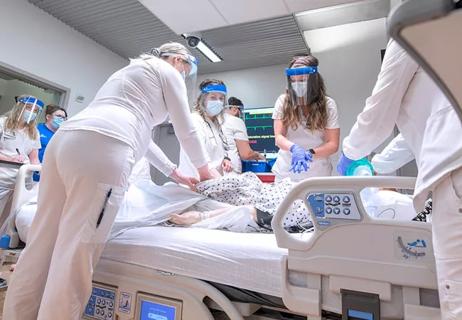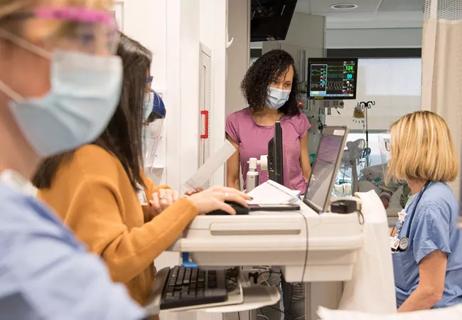At the 2017 Cleveland Clinic Patient Experience Summit, high reliability was an ever-present theme referred to by many speakers. As noted at the summit, high reliability is not possible without empathy. Interim ACNO of Clinical Practice and Quality Deborah Small, DNP, RN, NE-BC, says empathy is one of the hallmarks of care at Cleveland Clinic. Small is also the CNO of Cleveland Clinic Fairview Hospital.
Cleveland Clinic is a non-profit academic medical center. Advertising on our site helps support our mission. We do not endorse non-Cleveland Clinic products or services. Policy
According to The Joint Commission, there are five characteristics of high reliability organizations:
How does empathy fit into high reliability?
We have spent the past decade refocusing our efforts on putting patients first. This inherently starts with empathy, and our nursing leadership teams partner with the Office of Patient Experience to facilitate our responses using the HEART program models* created at Cleveland Clinic. Empathy is the caregiver’s ability to connect with the patient, and it provides the lens we need to provide personalized care planning through a shared decision-making process. When patients are involved in decision-making, they are more engaged – and care expectations translate into care adherence.
How is Cleveland Clinic making high reliability a part of its culture?
Caregivers know we are committed to achieving zero harm. We have removed barriers and encourage staff to speak up when they see improvement opportunities. We have worked on building trust and our leadership is very transparent with data; we share lessons learned from serious safety events. We have succeeded in meeting our quality targets and use dashboards to complete business reviews. We also use daily huddles on the units so front-line nurses can identify what could go wrong—we ask staff, “What one thing can we do to get better today?” It is a daily commitment to continuously get better.
How is high reliability embedded into your strategic plans?
High reliability is one of our enterprise priorities and our strategic agenda focuses on specific themes: patients first, caregivers, affordability, growth and impact. Each theme has key performance indicators that address communication, quality, safety, financial performance and resources utilization. Performance indicator targets help us measure our performance against our goals. Further, nursing institute priorities are integration and standardization.
What high reliability principles have you have borrowed from other industries?
We have implemented protocols and shared best practices across the system. Our Surgical Services team uses Universal Protocol time out, a checklist methodology to ensure that we have the right patient, site, procedure, position/prep and equipment. We have standardized common equipment (beds, IV pumps and defibrillators) and processes (CLABSI and CAUTI bundles, which have lowered the incidence of infections) to eliminate system-wide variation in practice.
What are you doing at the hospital level?
Effort has been spent in developing ownership and value for daily work using the continuous improvement (CI) processes. Many hospitals have continuous improvement “embeds” on primary medical units and with their help, we are driving process improvements. Over the past two years we have been educating staff on CI and the use of Kaizen boards as a tool for problem identification and solutions. The CI process has created synergy and engagement within teams.
How do you create accountability?
Real success comes from our culture. We want our nursing leaders to align work to what matters most. We pay attention to creating venues for optimal communication and interdisciplinary collaboration and reflect on what we could do better. Crucial conversations are important. Using TeamSTEPPS® scripting (“I have concern”) and other communications tools ensures that we adhere to our defined processes. Once we determine our needs, opportunities and issues, teams are encouraged to move forward toward prevention and optimization of care today.
Do you have any final thoughts?
We remain curious, ask for front-line feedback and encourage innovative ideas. Dr. Aaron Hamilton, Medical Director for Patient Safety, often describes the culture as one where leaders round and listen to the staff, creating opportunities to learn from each other to make a difference. (See story about leadership rounding.) High reliability becomes part of the culture when you can speak up – moving from “what did go wrong to what could go wrong” – from being reactive to proactive.
In the last decade, Leadership Rounding has become embedded into the Cleveland Clinic culture. Every day, hospital leaders round on the patient floors to ask patients key questions about their care. Are their concerns being addressed? Is their interprofessional team providing them with the information they need? Additionally, caregivers are asked about barriers they face to providing excellent care. This keeps hospital leadership informed about day-to-day operations, allowing leaders to solve problems in real time.
Additionally, once a month, members of the Cleveland Clinic health system leadership team and board members visit system hospitals to participate in leadership team rounding. This C-suite level rounding has included everyone from the CEO to the Chairman of the Board.
“Leadership rounding has brought an extra level of connectedness between patients, nurses and leaders,” says South Pointe Hospital CNO Sheila Miller, DNP, MBA, RN, NEA-BC. “And with regular visits from leadership, there is a level of professionalism that permeates everything we do as nurses.”
*Communicate with H.E.A.R.T. Program
In 2002, Cleveland Clinic’s Office of Patient Experience developed the Communicate with H.E.A.R.T.® program, and today it is a series of trainings for nurses. The program serves as a guide for all interactions between caregivers, patients and visitors, with the letters standing for Hear, Empathize, Apologize, Respond and Thank.

Leadership rounds educate nurses and foster teamwork

Veteran nurse shares his experience as a caregiver and community volunteer

Decision tree amplifies commitment

Hospital earns nine exemplars from the Magnet Recognition Program®

Supporting newly graduated RNs before and after the pandemic

PULSES sets forth six critical steps

Creating a roadmap to get everyone on board

SHINE program is seeing results